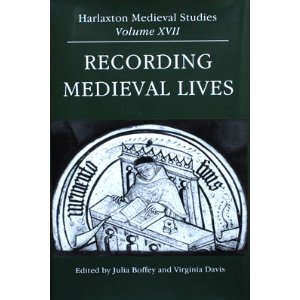Recording Medieval Lives
This book is a collection of essays based upon papers presented in 2005 at the Harlaxton Symposium, an annual interdisciplinary event on medieval history, art, literature and architecture. At the 2005 Symposium, the speakers had been invited “to explore the variety of forms in which medieval lives were recorded, and some of the many considerations which determined how such records were prompted or shaped”.
This, then, is an academic work, bristling with footnotes and bibliographies, but I was surprised to find how interesting it was for a non-specialist reader. I had not known how much of a merchant’s life could be recovered from the records kept by his scrivener (a sort of combination of clerk, lawyer, and accountant). I discovered that some medieval people, women as well as men, are known only by the chance discovery of their personal seals. It was a revelation to me that personal seals were owned by members of all levels of society. As you would expect, there are also essays dealing with better-known types of record such as wills and chronicles.
The concluding essay is a knowledgeable and mildly provocative look at “Historical Novels and Medieval Lives”, which includes mentions of the Historical Novel Society and of some of its members’ novels. It is interesting to have a non patronising examination by a historian of the historical novel as a source of information and misinformation.
I’ll certainly hold on to this book, and not only because it is an incidental source of lives that would make good subjects for historical novels. If you happen to read about Thomas Salter and plan a novel about his fascinating life and character, hands off: I’ve already bagged him.










